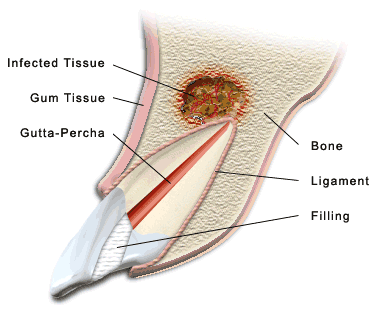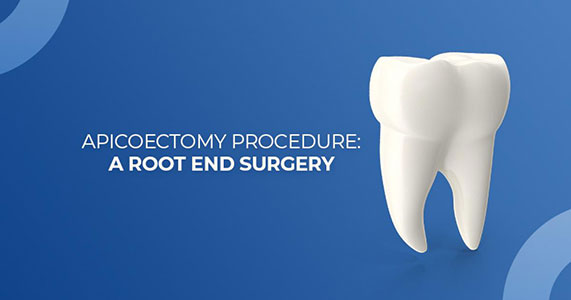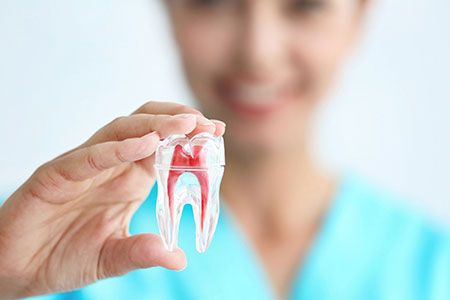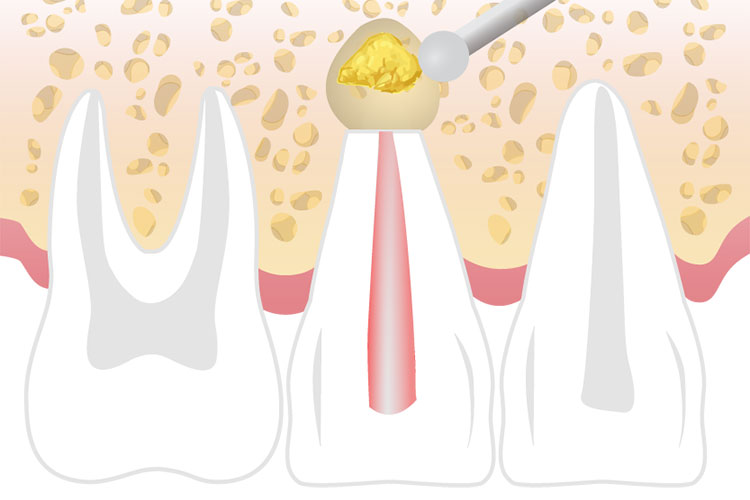Do you have a tooth that has already had root canal treatment and is still having issues?
This tooth may be a candidate for a root end procedure or apical surgery. St. Lawrence Dentistry has saved many teeth through this beneficial technique.
Root end procedure is an umbrella term for three separate procedures done in conjunction. These are apical curettage, apicoectomy, and retrofill. These are simple procedures to treat dental abscesses at the end of a tooth root. Dr. Hawryluk Jr. does them on teeth that exclusively have had root canal treatment or will have root canal treatment the same day.

When a tooth has a dental abscess, bacteria are present in the tooth and the bone surrounding the tooth (peri-radicular abscess). In this environment, the immune system cannot dissipate the bacteria because there is no blood supply in the tooth (and hence no immune cells). In this scenario, bacteria in the tooth replicate and spill into the surrounding bone. A root canal procedure treats the bacteria inside the tooth and “corks off” the end of the root. This procedure alone is usually enough to allow the bacteria in the bone to dissipate. When the root canal procedure siphons off the root end, the immune system usually has the power to control the bacteria in the bone, and it begins to dissipate. However, in the minority of circumstances, this is not the case. It is in these instances that the root end procedures can be effective.

If the bacteria persists at the end of the root despite root canal treatment, there are two options: redoing the root canal or doing a root end procedure. Root canals retreatment is ideal if there is an apparent deficiency in the root canal. It could include a missed canal or short root fill. If the pre-existing root canal treatment is ideal, usually there is no point in redoing it, and going direct to a root end procedure is the most reasonable. One main advantage of a root end procedure over redoing a root canal to address ongoing symptoms is the root end procedure directly removes any bacteria at the end of the root. On the other hand, redoing a root canal will only create an environment where the bacteria around the bacteria may begin to dissipate.

The first step in performing a root end procedure is gently pushing back the gingiva (gum) in the abscess area. When the bone is exposed, Dr. Hawryluk will often see a tiny opening leading to the dental abscess thru the bone. Therefore, magnification is critical, and the procedure should only be done by a dentist using a high-resolution dental microscope. After locating the abscess area, Dr. Hawryluk gently trephines a thin veneer of bone around the abscess until it is completely exposed. Next, the dentist removals all the abscess tissue in a process called Apical Curettage. It generally looks like a gelatinous tissue that is easy to spot with the microscope. Next, Dr. Hawryluk will trim the part of the root bathing in the abscessed tissue (apicoectomy), and then the remainder of the root end is packed with filling material (retrofill). We accomplish the root-end preparation for the retrofill by using ultrasonic instruments. Dr. Hawryluk Jr. uses the Satelec P5 Newton unit with special retro preparation tips for this process. Finally, Dr. Hawryluk will pack the end of the root with a substance called MTA or IRM, which research has found is the most effective retrofill material.

Root end procedures are valuable as they save teeth that otherwise need removal. Although they are technique sensitive and advanced equipment is required, the procedure is relatively straightforward with a comfortable recovery. If you are looking for a dentist in the Mississauga/Toronto area, please give St. Lawrence Dentistry a call!
- St. Lawrence Dentistry Looks Forward To St. Patrick’s Day! - March 12, 2025
- Understanding Dental X-Rays and Radiation: What You Should Know - January 13, 2025
- Happy New Year from St. Lawrence Dentistry! - December 30, 2024










